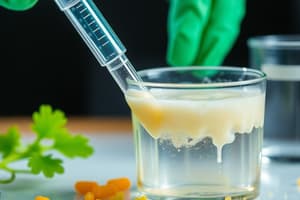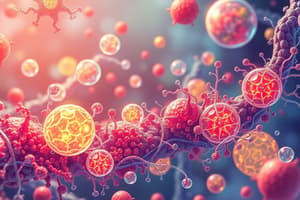Podcast
Questions and Answers
Which microorganisms are primarily associated with food biotechnology?
Which microorganisms are primarily associated with food biotechnology?
- Viruses and protozoa
- Archaea and bacteria
- Bacteria, yeast, and molds (correct)
- Fungi and algae
What is a major benefit of using biotechnology in the food industry?
What is a major benefit of using biotechnology in the food industry?
- Enhanced nutritional value (correct)
- Reduction of food waste
- Extended food shelf life
- Improvement of food aesthetics
Which factor is crucial to influencing microbial activity in food fermentation processes?
Which factor is crucial to influencing microbial activity in food fermentation processes?
- Nutrient availability and pH level (correct)
- Taste and aroma of ingredients
- Color and texture of food
- Temperature and pressure
Which technique is NOT typically associated with genetic engineering in food biotechnology?
Which technique is NOT typically associated with genetic engineering in food biotechnology?
Which enzyme type is primarily produced through microorganisms in food biotechnology?
Which enzyme type is primarily produced through microorganisms in food biotechnology?
What is an ethical concern associated with agricultural biotechnology?
What is an ethical concern associated with agricultural biotechnology?
What role do enzymes play in the process of chemical reactions?
What role do enzymes play in the process of chemical reactions?
Which enzyme is specifically used in the creation of lactose-free milk?
Which enzyme is specifically used in the creation of lactose-free milk?
What is the primary function of catalase in food processing?
What is the primary function of catalase in food processing?
Which type of rennet is most commonly used for cheese production?
Which type of rennet is most commonly used for cheese production?
In the brewing industry, which enzyme aids in providing amino acids for yeast fermentation?
In the brewing industry, which enzyme aids in providing amino acids for yeast fermentation?
What effect does protease have in cheese production?
What effect does protease have in cheese production?
Which statement is true regarding the relationship between proteins and enzymes?
Which statement is true regarding the relationship between proteins and enzymes?
What is the primary function of enzymes in biological systems?
What is the primary function of enzymes in biological systems?
Which of the following correctly describes enzyme cofactors?
Which of the following correctly describes enzyme cofactors?
Which type of proteins are specifically designed to perform functions rather than providing structural support?
Which type of proteins are specifically designed to perform functions rather than providing structural support?
What is the significance of amino acids in the structure of enzymes?
What is the significance of amino acids in the structure of enzymes?
Which of the following best describes the term 'biological catalyst'?
Which of the following best describes the term 'biological catalyst'?
Why are enzymes critical for chemical reactions in living cells?
Why are enzymes critical for chemical reactions in living cells?
Which of the following statements regarding structural proteins is correct?
Which of the following statements regarding structural proteins is correct?
What is formed when a substrate binds to an enzyme during a reaction?
What is formed when a substrate binds to an enzyme during a reaction?
Which of the following statements correctly describes co-factors in enzymatic reactions?
Which of the following statements correctly describes co-factors in enzymatic reactions?
Which term refers to the protein portion of an enzyme that requires a cofactor for activity?
Which term refers to the protein portion of an enzyme that requires a cofactor for activity?
What defines the transition state in an enzyme-catalyzed reaction?
What defines the transition state in an enzyme-catalyzed reaction?
What is the primary function of extracellular enzymes?
What is the primary function of extracellular enzymes?
Which type of interactions are important for substrate binding to the enzyme's active site?
Which type of interactions are important for substrate binding to the enzyme's active site?
Enzymes exhibit specificity due to which of the following factors?
Enzymes exhibit specificity due to which of the following factors?
What role do co-enzymes typically play in enzymatic processes?
What role do co-enzymes typically play in enzymatic processes?
Which characteristic of enzymes allows them to maintain fidelity in metabolic processes?
Which characteristic of enzymes allows them to maintain fidelity in metabolic processes?
Which feature is NOT associated with enzymes as catalysts?
Which feature is NOT associated with enzymes as catalysts?
Flashcards
What are enzymes?
What are enzymes?
Enzymes are biological catalysts that speed up chemical reactions without being consumed in the process.
Food Biotechnology
Food Biotechnology
Food biotechnology is a branch of biotechnology that focuses on the use of living organisms and their components to produce, process, and improve food products.
Fermentation
Fermentation
Fermentation is a process that involves the breakdown of organic molecules by microorganisms, often bacteria or yeast, to produce desired products like alcohol, acids, or gases. This process is crucial for producing many food products.
Genetic Engineering in Food
Genetic Engineering in Food
Signup and view all the flashcards
Enzymes in Food Industry
Enzymes in Food Industry
Signup and view all the flashcards
Nanotechnology in Food
Nanotechnology in Food
Signup and view all the flashcards
What are proteins?
What are proteins?
Signup and view all the flashcards
What are structural proteins?
What are structural proteins?
Signup and view all the flashcards
What are functional proteins?
What are functional proteins?
Signup and view all the flashcards
What is an enzyme?
What is an enzyme?
Signup and view all the flashcards
Is it true that all proteins are enzymes?
Is it true that all proteins are enzymes?
Signup and view all the flashcards
What is the chemical nature of enzymes?
What is the chemical nature of enzymes?
Signup and view all the flashcards
What are enzyme cofactors or coenzymes?
What are enzyme cofactors or coenzymes?
Signup and view all the flashcards
What is the structure of enzymes?
What is the structure of enzymes?
Signup and view all the flashcards
Activation Energy
Activation Energy
Signup and view all the flashcards
How do enzymes affect activation energy?
How do enzymes affect activation energy?
Signup and view all the flashcards
What is rennet?
What is rennet?
Signup and view all the flashcards
What is lactase?
What is lactase?
Signup and view all the flashcards
What is protease?
What is protease?
Signup and view all the flashcards
What is an Apoenzyme?
What is an Apoenzyme?
Signup and view all the flashcards
What is a Holoenzyme?
What is a Holoenzyme?
Signup and view all the flashcards
What are Intracellular enzymes?
What are Intracellular enzymes?
Signup and view all the flashcards
What are Extracellular enzymes?
What are Extracellular enzymes?
Signup and view all the flashcards
What is a Substrate?
What is a Substrate?
Signup and view all the flashcards
What is the Active Site?
What is the Active Site?
Signup and view all the flashcards
What happens when the substrate binds?
What happens when the substrate binds?
Signup and view all the flashcards
What is an enzyme-substrate complex?
What is an enzyme-substrate complex?
Signup and view all the flashcards
What is a Product?
What is a Product?
Signup and view all the flashcards
What is Enzyme Catalysis?
What is Enzyme Catalysis?
Signup and view all the flashcards
Study Notes
Introduction to Biotechnological Applications in the Food Industry
- Dr. Eman Owis, a lecturer of Microbial Biotechnology from Mansoura University in Germany, presented on this topic.
Food Biotechnology
- Food biotechnology is a broad area, encompassing many techniques and applications.
- Microorganisms, like bacteria, yeasts, and molds, play a critical role in many food processes.
- Factors influencing microbial activity vary, impacting the success of different food processes. The importance of bacteria and yeasts in the food industry is significant.
- Biotechnology in the food industry has several benefits. Food safety and regulations play a significant role.
- Specific techniques associated with food biotechnology differ based on the application.
- Enzymes are important biological catalysts.
- Nanotechnology also has applications in agriculture and the food industry.
- Ethical aspects of food and agricultural biotechnology are important considerations.
Enzymes in Food Industry
- Introduction, production of food enzymes from microorganisms, and ethical implications are discussed.
- Different enzymes with their specific uses in the food industry vary.
Outcomes of the Lecture
- This presentation included information on the nature of enzymes including:
- historical context
- chemical nature
- structure of enzymes
- enzyme catalysis
- applications
- Enzymology is the branch of science focused on the biochemical nature and activity of enzymes.
- Enzymologists are specialists in this area.
- Various enzymes are listed by name.
Proteins and Enzymes
- Proteins are macromolecular components often folded into globular or fibrous shapes. They can be structural or functional.
- Structural proteins include those creating protective coverings like skin, hair, and wool. Others form connective tissues like tendons.
- Functional proteins, including enzymes such as (examples of specific enzymes given).
- Not all proteins are enzymes but all enzymes are proteins.
What is an Enzyme?
- Enzymes are functional proteins that accelerate biochemical reactions acting as biological catalysts.
- Enzymes are involved in all chemical reactions within a cell.
- Through substrate binding, enzymes catalyze reactions via a catalytic step involving an intermediate enzyme-substrate complex.
- The reactants in an enzyme-catalyzed reaction are called substrates, and the result of the reaction are products.
- The activation energy required for a (specific) reaction is lowered by the presence of an enzyme, enabling faster reactions.
- The free energy change of the reaction remains constant regardless of whether an enzyme is present.
Enzyme Structure
- Some enzymes require non-protein chemical groups called cofactors or coenzymes to fulfill certain reactivity needs.
- Cofactors may be either inorganic or organic molecules.
- Specific types of Inorganic cofactors, including metal ions (e.g., and copper), are important.
- Organic, like H-bonding and hydrophobic interactions, are important for cofactor activity. Co-enzymes are organic cofactors that are bonded to the enzyme prior to the other substrate-bound and aid in many different chemical reactions.
- The protein portion of an enzyme that requires a cofactor for full activity is referred to as the apoenzyme.
- The catalytic complex formed between the apoenzyme and its cofactor is called the holoenzyme.
Types of Enzymes
- Enzymes can be extra-cellular or intra-cellular. This includes examples for each type.
How Enzymes Work Efficiently
- Enzymes accelerate the rate of chemical reactions.
- Enzymes act on specific molecules.
- Enzymes and substrate interaction produces specific products.
Enzyme-Substrate Interaction
- The formation of an enzyme-substrate complex is the first step in an enzyme-catalyzed reaction.
- The substrate binds to the enzyme at the active site primarily through non-covalent interactions.
- These interactions include hydrogen bonding, electrostatic interactions and hydrophobic interactions, as well as van der Waals forces.
What Happens After Binding?
- For reactions to proceed, reactants' (A) energy increases to overcome the activation energy to produce products (B).
Chemical Nature of Enzymes
- Enzymes and proteins consist of a linear chain of amino acids linked via peptide bonds. Different amino acid sequences create different enzymes.
Enzyme Structure Details
- Primary, secondary, tertiary, and quaternary structures of proteins are discussed along with an illustration of the structures.
- Various structural components are discussed with examples such as beta strands, alpha helices, and loops and turns along with different structural properties.
Applications of Enzymes in the Food Industry
- Various industries including dairy, brewing, baking, and wine/juice production use specific enzymes.
- List of example enzymes used in food industries across the listed food production sectors.
Specific Types of Enzymes and Uses
-
Detailed explanations of the different enzymes, their applications in various food industries, such as rennet, lactase, and protease, along with their individual benefits.
-
Additional specific enzymes and their roles are discussed: catalase, protease, beta-glucanase a-amylase, maltogenic amylase, glucose oxidase, and pectinase, with examples and detailed explanation of use in their respective food industry sectors.
The Brewing Process
- Steps of brewing with diagrams displayed (e.g. milling, mashing, lautering, boiling, fermentation, bottling, and aging).
- The roles of specific enzymes in the process
- Key enzymes like protease, beta-glucanase, a-amylase, and amyloglucosidase.
Conclusion
- The importance of enzymes in all aspects of life is highlighted, emphasizing its role and significance in physiological and other biological processes.
Studying That Suits You
Use AI to generate personalized quizzes and flashcards to suit your learning preferences.




